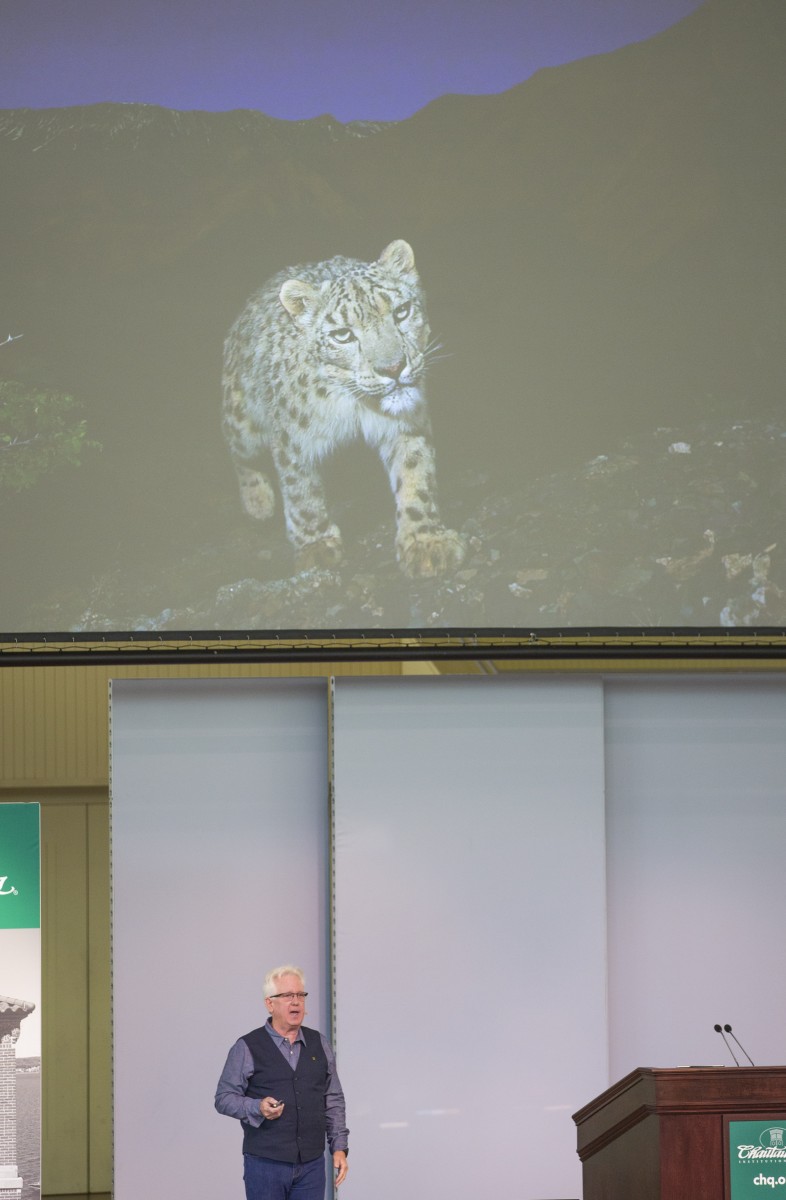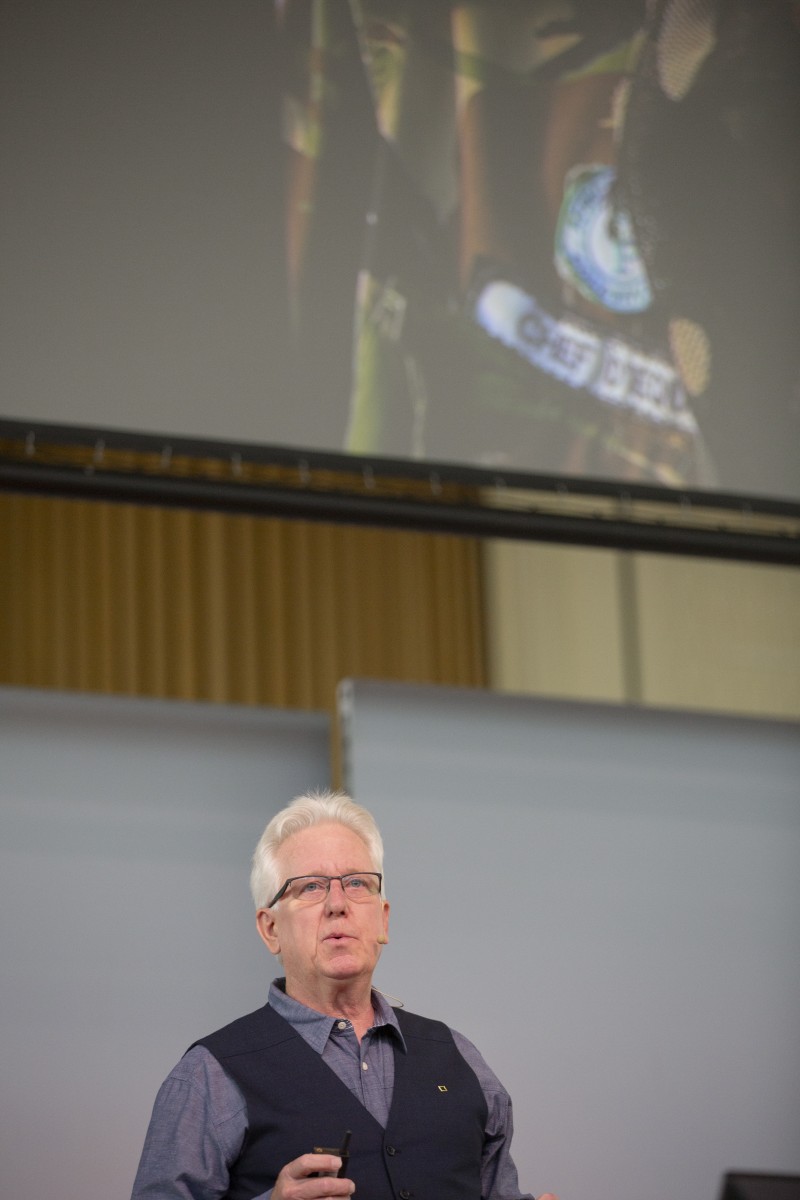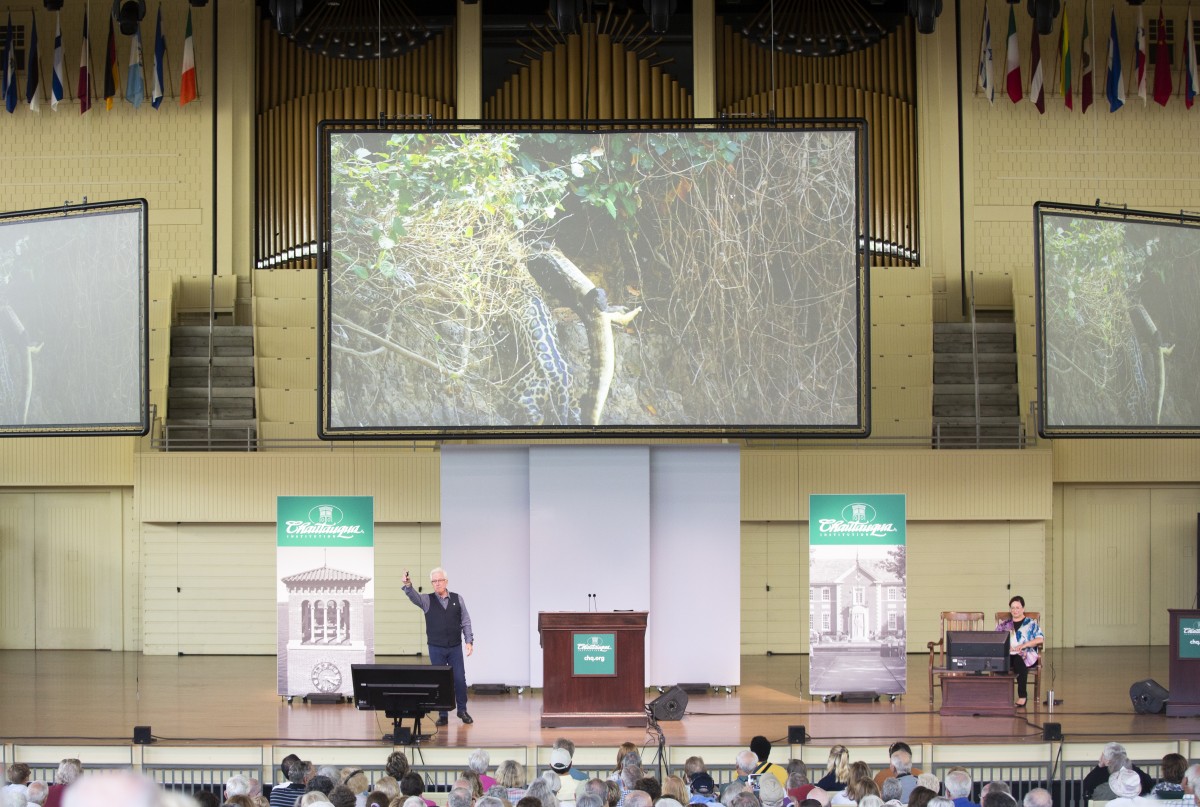Steve Winter didn’t choose big cats, big cats chose him.
Ironically, his fascination with cats began with a bird. Winter was in the mountains of Guatemala photographing the plumed quetzal when a black panther approached his cabin. Despite Winter’s initial fear, the coincidental meeting set the stage for what would become a career dedicated to the world’s big cats — sharing their beauty while reinvigorating efforts to save them from impending extinction.
Winter, National Geographic wildlife photographer, took Chautauquans on assignment through his viewfinder with the help of four big cats at 10:45 a.m. Tuesday in the Amphitheater, continuing Week Three, “A Planet in Balance: A Week in Partnership with National Geographic Society.”
“In the past, scientists have said, ‘Don’t anthropomorphize these animals,’ ” Winter said. “Throw that out the window because that has separated us from nature and we need to come back to nature, because we are animals and we are part of the world, the planet and its balance.”
For his lecture, Winter chose jaguars, snow leopards, cougars and tigers: Four apex predators in their respective ecosystems with no natural predators of their own — besides humans.
Winter started with jaguars, the subject of his first big cat story for National Geographic. To familiarize himself with the species, he began researching, only to find the magazine had never done a story on jaguars before.
“I thought, ‘This is great, I’ll be the first,’ ” Winter said. “My wife says, ‘Don’t you figure if in 107 years, if National Geographic has never done a story on the world’s third-largest cat there’s probably a pretty good reason why?’ ”
Regardless of his wife’s sound reasoning, Winter took on the story. After an unsuccessful attempt in Belize, he was invited to try again in Pantanal, Brazil, a region that is 95% privately owned by mostly cattle ranchers.
“Most of these cattle ranchers thought the only good jaguar was a dead jaguar; that all cattle death has to be attributed to jaguars,” he said. “I knew this could not be true.”
To prevent more unnecessary jaguar deaths, Winter partnered with local scientists to put GPS satellite collars on the cats to prove they were nowhere near the livestock.
“These animals could be saved, and the way they were saved is photographs in National Geographic,” he said. “The area of Pantanal then became an eco-tourism mecca. People came from all around the world to see the world’s third- largest cat and all of the birds within (the region).”
Winter returned to Pantanal for another story on jaguars. During that trip he took his “holy grail” photo — an image of a female with one of her cubs.
One day, Winter received an email from his editor asking the staff to pitch their dream assignment. He chose a story on snow leopards.
— The Chautauquan Daily (@chqdaily) July 9, 2019
“Well, I just did a story on a cat I hardly ever saw, so why don’t I do a story on a cat I’ll never see?” he said.
The first part of the assignment was choosing the prime location that would provide the greatest possibility of spotting a snow leopard. Bringing along 33 bags of equipment and clothes, Winter and his team went to the Indian Himalayan Region. At altitudes of over 17,000 feet, his team worked with local scientists to place camera traps in spots that would capture his ideal composition. After three days, he started getting photos of snow leopards.
“I had someone in the camp, saying ‘Steve, you’ll never get a picture of a cat here during the day,’ ” he said. “I always thought when a human tells you what an animal is going to do, I figure the animal is going to do the exact opposite.”
Winter met yak herders on the mountain who were killing snow leopards to protect their livestock, their main source of income. In addition to deaths from predators, the herders were also losing 30% of livestock to disease. Winter and his team agreed to vaccinate all the livestock as long as the herders promised to stop killing cats.
“You turn an economic negative into an economic positive, and benefit humans and snow leopards at the same time,” he said.
After seven months, 14 traps and 42 locations, Winter captured the first existing photo of a snow leopard in a snowstorm, earning him BBC’s Wildlife Photographer of the Year award.
“If I wanted to be a National Geographic photographer since I was 8 years old, I figured I had already won,” he said. “The story starts on the pages of National Geographic, and when you win these awards, millions more people get to see the issues surrounding the species you’re working on, and the story travels through.”
The next big cat he photographed was a tiger, the largest and most endangered cat in the world. A century ago, 100,000 tigers roamed 31 countries. Now, there are approximately 3,500 tigers left in six countries.
“In Asia they are balancing the need for development and a growing population with their love for big cats, tigers and leopards,” he said.
“I had to work on these camera traps and figure out how I could get a picture of a snow leopard with composition,” says Winter. pic.twitter.com/87TlfdB8eD
— The Chautauquan Daily (@chqdaily) July 9, 2019
He was on a shoot in Myanmar’s Hukawng Valley when he proposed a story on an emerging national park for tigers. Between the time he proposed the story and got to the valley, 50,000 gold miners rushed in, bringing traders from the Chinese medicine market along with them.
Winter photographed groups of people reducing huge portions of the tigers’ forest home to wasteland, and poachers who were illegally hunting and trading cats. When his photos were published, the miners were forced out and the valley became the world’s largest tiger reserve.
Winter moved on to India’s Kaziranga National Park. This small reserve, nestled in the Brahmaputra floodplain, is home to more tigers than any other place in the world. Because of the tiger population, the park is also home to 500 guards to fend off poachers. According to Winter, poachers were killing the cats for only $100 per tiger.
The tigers were originally poached for Chinese medicine, but the motive changed from health to wealth when tiger products became status symbols. These products are being locked in safes by people banking on the tigers’ extinction, but Winter believes there’s still hope. Public service announcements featuring movie stars and athletes are being shared in China to influence young people’s views on the value of tigers in nature.
“Their tagline is, ‘When the buying stops, the killing can too,’ ” he said. “We can’t put guards around national parks everywhere. We need to change the demand for these endangered species’ products.”
Tigers are also the subject of one of Winter’s most rewarding investigative pieces. He went to Thailand to investigate the Tiger Temple, essentially a theme park sprawling over 60 acres of land. Every afternoon, tigers were led on chain leashes to the “canyon,” an artificial habitat used for tourist pictures.
The numbers didn’t add up. The park always had 150 tigers, but visitors could feed cubs 365 days a year. That meant they were breeding tigers without the numbers ever increasing, which raised a red flag to Winter regarding illegal trade.
“You turn an economic negative into and economic positive, benefit humans and snow leopards at the same time,” says Winter. pic.twitter.com/8BcY5Mz5oo
— The Chautauquan Daily (@chqdaily) July 9, 2019
Winter also found out the tigers were being drugged to make them safe around humans. In response, Winter and his wife, National Geographic correspondent Sharon Guynup, produced a video exposing the park’s conditions with anonymous sources supporting Winter’s assumption of tiger trade-offs.
The video was released on National Geographic’s website in 2014, and spread to news organizations across the world. Guynup wrote four additional articles and by the fourth, the government confiscated all 163 tigers.
“What they found was a horror show,” Winter said. “There were 40 tigers hanging on meat hooks in the freezer and 20 cubs in jars. They were involved in illegal trade.”
Winter eventually took an assignment in the United States covering big cats in big cities. He took on mountain lions in Los Angeles, the first time National Geographic Magazine featured the species.
The first scientist he talked to told him no cats would walk in front of the Hollywood sign or in a place with a city view in the background. After 15 months of camera traps in Griffith Park, Winter finished the assignment with photos of both, starting a “necessary conversation” in Los Angeles.
“Because of the power of photography and these images, they’re now going to build the largest wildlife corridor pass in the world, 13 miles north of L.A.” he said.
Big cats have faced numerous trials in Winter’s career alone, but according to him, their adaptability is their greatest asset.
“They thrive on just the basics: food, water and a secure place to live,” he said. “When you add strong laws, protection and careful monitoring, big cats bounce back.”
Still, people often ask him, “Why save big cats?” Other than the fact that their existence simply “gives them the right to walk the earth,” he has a second, far more inclusive, answer to that question.
“When we save animals with these wide-ranging habitats, we can actually help save us,” he said. “If we can save big cats, we can help save ourselves. Where there’s life, there’s hope. The time to act is now.”
Winter closes with, “If we can help big cats, we can help save ourselves.” #CHQ2019 pic.twitter.com/4y0Mpn01Sr
— The Chautauquan Daily (@chqdaily) July 9, 2019








